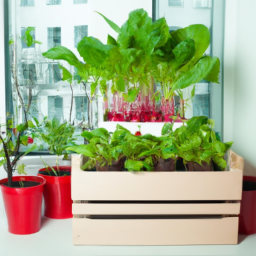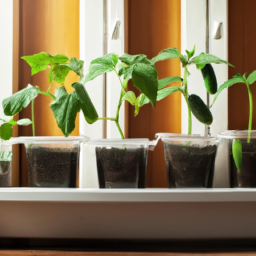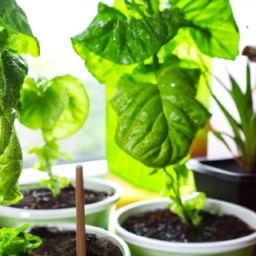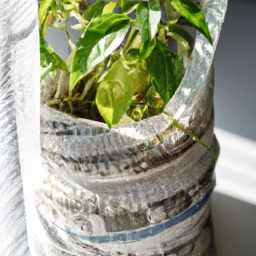
Are you interested in learning how to grow indoor vegetables? Whether you’re looking to save money on groceries, enjoy fresh produce year-round, or just want to try your hand at gardening, growing vegetables indoors can be a rewarding and fun experience. With the right tools and knowledge, you can easily grow a variety of vegetables right in your own home, no matter the season or the size of your living space. In this blog post, we’ll cover everything you need to know to get started with indoor vegetable gardening, from choosing the right plants to setting up your indoor garden space. Let’s dive in and discover the joys of growing your own indoor vegetables!
Benefits of Growing Indoor Vegetables
Introduction
Growing vegetables indoors can be a rewarding and beneficial experience for many reasons. Not only does it provide a convenient way to have fresh produce at your fingertips, but it also allows you to control the growing environment and ensure that your vegetables are free from harmful pesticides and chemicals. In this guide, we will explore the various benefits of growing indoor vegetables and provide you with tips on how to get started.
Health Benefits
One of the main benefits of growing indoor vegetables is the health benefits that come with consuming fresh, homegrown produce. Indoor vegetables are free from harmful pesticides and chemicals that are often used in commercial farming, making them a healthier option for you and your family. Additionally, indoor vegetables are picked at their peak ripeness, which means they are packed with nutrients and vitamins that can boost your overall health and well-being.
Growing your own vegetables indoors also allows you to have a constant supply of fresh produce throughout the year, regardless of the season. This can help you maintain a balanced diet and ensure that you are getting the nutrients your body needs to stay healthy. By growing your own vegetables indoors, you can also experiment with different varieties that may not be readily available at your local grocery store, allowing you to expand your palate and try new and exciting flavors.
In addition to the health benefits of consuming fresh, homegrown produce, growing indoor vegetables can also have positive effects on your mental health. Gardening has been shown to reduce stress and anxiety, improve mood, and increase feelings of happiness and well-being. By tending to your indoor vegetable garden, you can connect with nature, practice mindfulness, and enjoy the therapeutic benefits of caring for living plants.
Environmental Benefits
Growing vegetables indoors can also have positive effects on the environment. By growing your own produce at home, you can reduce your carbon footprint by eliminating the need for transportation and packaging that are associated with store-bought vegetables. Indoor gardening also allows you to conserve water by using efficient watering systems such as drip irrigation or hydroponics, which can help reduce water waste and promote sustainability.
In addition to conserving resources, growing indoor vegetables can also help reduce food waste. When you grow your own produce, you can harvest only what you need, which can help prevent excess vegetables from going to waste. Indoor gardening also allows you to compost vegetable scraps and plant trimmings, which can be used to enrich the soil and create a closed-loop system that promotes sustainability and reduces waste.
Furthermore, growing vegetables indoors can help promote biodiversity by providing a habitat for beneficial insects and pollinators. By creating a healthy and diverse indoor garden, you can attract bees, butterflies, and other beneficial insects that can help pollinate your plants and control pests naturally. This can help reduce the need for harmful pesticides and chemicals, creating a more sustainable and eco-friendly growing environment.
In conclusion, growing indoor vegetables offers a wide range of benefits, from improved health and well-being to reduced environmental impact. By starting your own indoor vegetable garden, you can enjoy fresh, nutritious produce year-round, connect with nature, and contribute to a more sustainable and eco-friendly lifestyle. So why wait? Start growing your own indoor vegetables today and reap the many rewards that come with it.

Best Vegetables to Grow Indoors
Are you looking to grow your own vegetables indoors but not sure where to start? In this guide, we will explore the best vegetables to grow indoors and provide you with step-by-step instructions on how to do so successfully. Growing vegetables indoors can be a rewarding experience and a great way to have fresh produce right at your fingertips. Let’s get started!
Tomatoes
Tomatoes are one of the most popular vegetables to grow indoors. They are relatively easy to grow and can thrive in containers with plenty of sunlight. To grow tomatoes indoors, you will need a large container, potting soil, tomato seeds or seedlings, and a sunny spot near a window. Make sure to water your tomato plants regularly and provide support as they grow taller. With proper care, you can enjoy delicious, homegrown tomatoes all year round.
When growing tomatoes indoors, it is important to choose a variety that is well-suited for indoor growing. Cherry tomatoes, patio tomatoes, and determinate varieties are all good options for indoor cultivation. Make sure to provide your tomato plants with enough sunlight, ideally 6-8 hours per day, and keep the soil consistently moist but not waterlogged. With proper care, your tomato plants should start producing fruit within a few months.
In addition to regular watering, tomatoes will also benefit from occasional fertilization. Use a balanced fertilizer every 2-3 weeks to ensure that your plants have all the nutrients they need to thrive. Prune your tomato plants regularly to promote healthy growth and prevent overcrowding. With a little bit of effort, you can enjoy a bountiful harvest of fresh, flavorful tomatoes right from your own home.
Peppers
Peppers are another great vegetable to grow indoors. They are relatively low-maintenance and can thrive in containers with plenty of sunlight. To grow peppers indoors, you will need a large container, potting soil, pepper seeds or seedlings, and a sunny spot near a window. Peppers prefer warm temperatures, so make sure to keep your plants in a warm, sunny location.
When growing peppers indoors, it is important to choose a variety that is well-suited for indoor growing. Mini bell peppers, jalapenos, and banana peppers are all good options for indoor cultivation. Make sure to water your pepper plants regularly and provide support as they grow taller. Peppers can be slow to germinate, so be patient and give your plants time to grow.
Peppers will benefit from regular watering and occasional fertilization. Use a balanced fertilizer every 2-3 weeks to ensure that your plants have all the nutrients they need to thrive. Prune your pepper plants regularly to promote healthy growth and prevent overcrowding. With proper care, you can enjoy a steady supply of fresh, flavorful peppers right from your own home.
Herbs
Herbs are some of the easiest vegetables to grow indoors. They are low-maintenance and can thrive in small containers on a sunny windowsill. To grow herbs indoors, you will need small containers, potting soil, herb seeds or seedlings, and a sunny spot near a window. Herbs like basil, parsley, mint, and cilantro are all good options for indoor cultivation.
When growing herbs indoors, it is important to provide your plants with enough sunlight, ideally 6-8 hours per day. Herbs prefer well-draining soil, so make sure to water your plants regularly but allow the soil to dry out between waterings. Herbs are fast-growing and can be harvested frequently for use in cooking or for making herbal teas.
Herbs will benefit from occasional fertilization. Use a balanced fertilizer every 2-3 weeks to ensure that your plants have all the nutrients they need to thrive. Prune your herbs regularly to promote healthy growth and prevent overcrowding. With proper care, you can enjoy a continuous supply of fresh, aromatic herbs right from your own home.

Tips for Successfully Growing Indoor Vegetables
Are you interested in growing your own vegetables indoors but not sure where to start? Indoor vegetable gardening can be a rewarding and fun experience, but it does require some knowledge and care to be successful. In this guide, we will provide you with some tips on how to successfully grow vegetables indoors.
Choose the Right Vegetables
When it comes to growing vegetables indoors, not all plants are created equal. Some vegetables are better suited for indoor growing than others. When selecting vegetables to grow indoors, consider factors such as light requirements, space constraints, and temperature preferences. Some vegetables that are well-suited for indoor growing include herbs like basil, parsley, and cilantro, as well as leafy greens like lettuce and spinach.
Before you start planting, make sure to research the specific needs of the vegetables you plan to grow. Some vegetables may require more light or space than others, so it’s important to choose plants that are compatible with your indoor gardening setup.
Additionally, consider the size of your indoor space when choosing vegetables to grow. Some plants, like tomatoes or peppers, may require more vertical space to grow properly, while others, like microgreens or herbs, can thrive in smaller containers.
Provide Adequate Light
One of the most important factors in successful indoor vegetable gardening is providing adequate light for your plants. Most vegetables require at least 6-8 hours of sunlight per day to thrive, so it’s important to place your plants in a location where they can receive enough light.
If you don’t have access to natural sunlight, you can use artificial grow lights to provide your plants with the light they need. LED grow lights are a popular choice for indoor vegetable gardening because they are energy-efficient and provide a full spectrum of light that plants need to grow.
When using grow lights, make sure to position them at the right distance from your plants to prevent burning or overexposure. You may need to adjust the height of the lights as your plants grow to ensure they are receiving the right amount of light.
Maintain Proper Temperature and Humidity
In addition to light, temperature and humidity are important factors to consider when growing vegetables indoors. Most vegetables prefer temperatures between 65-75 degrees Fahrenheit during the day and slightly cooler temperatures at night.
To maintain the proper temperature for your plants, consider using a space heater or a fan to regulate the temperature in your indoor gardening space. You can also use a humidifier to increase humidity levels if necessary, especially during the winter months when indoor air tends to be dry.
It’s also important to monitor the moisture levels in the soil to prevent overwatering or underwatering your plants. Use a moisture meter to check the soil regularly and adjust your watering schedule as needed to keep your plants healthy and thriving.
By following these tips and providing your indoor vegetables with the right conditions, you can successfully grow a variety of vegetables indoors year-round. With a little time and effort, you can enjoy the satisfaction of harvesting fresh, homegrown vegetables right from your own indoor garden.
Let’s wrap up what we learned
Are you interested in growing your own vegetables but don’t have a backyard or outdoor space? No worries, you can still enjoy the satisfaction of growing your own produce by starting an indoor vegetable garden! With the right tools and techniques, you can easily grow a variety of vegetables right in your own home.
To start your indoor vegetable garden, you’ll need to choose a sunny spot in your home that gets at least 6-8 hours of sunlight a day. You can also supplement with grow lights if needed. Next, choose the vegetables you want to grow – popular options include tomatoes, peppers, lettuce, and herbs. Make sure to use a good quality potting mix and containers with drainage holes to ensure your plants have proper soil and water drainage. With a little bit of care and attention, you’ll be able to enjoy fresh, homegrown vegetables all year round!
Check Out These FAQs:
Q1: What are the best vegetables to grow indoors?
A1: Some of the best vegetables to grow indoors include leafy greens like lettuce and spinach, herbs like basil and parsley, and compact vegetables like cherry tomatoes and peppers.
Q2: What kind of light do indoor vegetables need to grow?
A2: Indoor vegetables need at least 6-8 hours of sunlight per day, so it’s important to place them near a sunny window or use grow lights to provide the necessary light for their growth.
Q3: How often should I water my indoor vegetables?
A3: It’s important to keep the soil of your indoor vegetables consistently moist, but not waterlogged. Check the soil regularly and water when the top inch feels dry to the touch.
Q4: Do indoor vegetables need fertilizer?
A4: Yes, indoor vegetables will benefit from a balanced liquid fertilizer every 2-4 weeks to ensure they are getting the necessary nutrients for healthy growth.
Q5: How can I protect my indoor vegetables from pests?
A5: To protect your indoor vegetables from pests, regularly inspect the leaves and stems for any signs of infestation. You can also use natural remedies like neem oil or insecticidal soap to control pests if necessary.
Dr. Olivia Green is a botanist with over two decades of experience in indoor plant cultivation. She holds a Ph.D. in Plant Biology and has dedicated her career to researching plant behavior in controlled environments. Dr. Green is passionate about helping plant enthusiasts master the art of indoor gardening through her extensive knowledge and practical insights.


